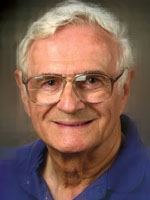
Robert L. Sinsheimer
University of California at Santa Barbara
Significant Firsts
As a molecular biologist I have throughout my career wanted to understand the nature of life. It has been my good fortune to live in the greatest period thus far in the history of biological science–the era when the machinery of life became evident, when enzymes and genes and viruses became tangible, when subcellular structures, fibers, particles, channels, and vesicles emerged discretely from the obscurity of protoplasm. The Gordon Research Conferences played an instrumental role in these advances. Their own internal genetic structure–formal sessions tempered by discussions during free time–allowed new ideas to combine and recombine in a way that greatly advanced molecular biology during the last fifty-five years.
I came to molecular biology from an interest in math. As an undergraduate at the Massachusetts Institute of Technology (MIT) I switched from engineering to a new program in biological engineering. Since the department was so new, I took an eclectic range of courses. During World War II, I was involved in developing and testing airborne radar systems as a staff member, but after the war I returned to biology and completed my graduate studies at MIT. It was an exciting time because researchers such as George Beadle, Edward Tatum, and others were linking genes to enzymes, identifying DNA as the source of inheritance, and proving that nucleic acids could be genetic material.
When I finished my Ph.D., the job market for biophysicists was not strong, mostly because few people had heard of the field. Fortunately, Iowa State University had an opening in the physics department. Once there I was the only person in a large geographical radius working on nucleic acids. Toward the end of my first year at the university in 1949, I saw a notice that a Gordon Conference called Physical Methods in Nucleic Acid and Protein Research was to be held in the summer of 1950. Situated far from the action on either coast, I applied to attend and was accepted. The conference was a remarkable event: there were some ninety-five participants, including almost everyone who was doing physicochemical, structural, or metabolic studies on nucleic acid or protein molecules. In the years after the 1950 meeting the field expanded significantly.
During the first half of 1953 I took a six-month leave of absence to work with Max Delbrück at the California Institute of Technology (Caltech). This was a critical period: Linus Pauling gave a seminar describing a three-strand helix for DNA, and a short time later James Watson and Francis Crick came out with their two-strand helical model. My own research at the time shifted to phage genetics, specifically a focus on Phi X 174, a virus that can grow in
Escherichia coli. In 1957 I was invited to set up a lab at Caltech. In the coming years we were able to identify key features of Phi X, including its ring structure as a novel, single-stranded form of DNA. We eventually synthesized an infective DNA strand in 1967 using DNA polymerase together with DNA ligase and Phi X DNA.
Throughout this period of research I actively sought out the most recent work in the field. Most good research would of course ultimately appear in publications, but only after a delay of six months or more. To hear it sooner, I became a regular attendee at the summer Gordon Conferences.
I was asked to chair the 1960 Proteins and Nucleic Acids Conference, the last year when both fields were discussed at the same GRC. By the early 1960s hundreds of applicants sought to attend, so we split the series into two conferences–one devoted to proteins and the other to nucleic acids. The Nucleic Acids Conference continued to grow and soon alternated each year’s focus between structural studies and metabolic and functional studies.
It is a pity that better records were not made of the Gordon Conferences in the 1950s and 1960s. Here great advances and significant smaller steps were first presented, discussed, and criticized in the informal, open, and friendly fashion that GRC supports. Here Fred Sanger presented the first amino acid sequence of a protein–specifically, insulin. The sequencing of the adrenocorticotropic hormone was not far behind. At a Gordon Conference, Julius Marmur and Paul Doty described their remarkable discovery of DNA renaturation, which is the basis of much of today’s molecular genetics. The enzymology of DNA and RNA was progressively elaborated. Here, too, Francis Crick presented his “adaptor” hypothesis to link nucleic acid sequence to amino acid sequence and his “commaless” mode. Mahlon Hoagland and Paul Zamencik described their discovery of transfer RNA. Bacterial transforming factors and viral structures were analyzed, and the relationship of DNA structures to genetic factors was progressively refined. Gradually, year by year, the modes of synthesis of DNA, RNA, and proteins were clarified.
We live in a unique time in the history of life on Earth, the time when a species first began to understand its origins, its inheritance, and its biological functions. Gordon Conferences have been there for every step of this remarkable journey.